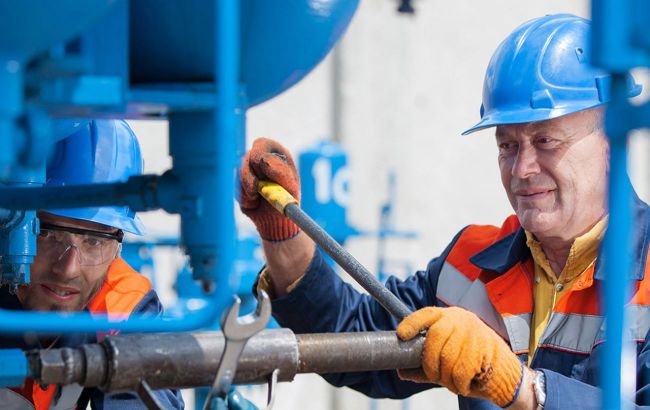Transit during war: Will Ukraine continue Russia to EU gas supplies without contract with Gazprom?
 Ukraine's GTS (photo: ОGTSU (operator of the gas transmission system of Ukraine) press service)
Ukraine's GTS (photo: ОGTSU (operator of the gas transmission system of Ukraine) press service)
Russia's war against Ukraine hasn't halted the transit of Russian gas to Europe through the Ukrainian gas transit system (GTS). However, after the contract expires in 2024, Ukraine won't be renewing the agreement with the aggressor. The conditions under which gas transit from Russia can be maintained and who's interested in it are detailed in a report by RBC-Ukraine.
Public comments from Ukrainian and European officials, exclusive information from RBC-Ukraine sources, as well as comments from the Ukrainian GTS Operator and experts were used in preparing the material.
Contents
- Can there be transit without a contract with Russia's Gazprom?
- Who is interested in gas transit through Ukraine
- Ukraine's GTS Operator does not exclude that transit will continue after 2024
- Future of Ukraine's gas transit tariff: What to expect
- Ukraine's losses from transit cessation
- Future of Ukraine's GTS
The contract for Russian gas transit through Ukraine, signed at the end of 2019 between Naftogaz Ukraine and Russia's Gazprom, terminates on December 31, 2024. The term of the contract could theoretically be extended. However, Ukraine has categorically stated its refusal to consider such an option.
"We certainly have no intention of negotiating with the aggressor country to extend (the contract) and put our signatures under the agreement," said Ukrainian Prime Minister Denys Shmyhal.
Europe shows no interest in extending the transit contract. European Commissioner for Energy Kadri Simson assured that returning to normal relations with Russia is impossible.
"We have been preparing for the end of this contract for two years when manipulations in the gas market began, and we have alternative options to ensure supply security," Simson said.
While Russia hasn't made any specific statements, remarks from Vladimir Putin suggest they're not against continuing gas supplies through Ukraine even after 2024 - it all depends on European buyers. "Let them decide themselves (in the EU), if they need it - let them take it (gas), if not - we'll manage," he said in an interview in February.
Can there be transit without a contract with Russia's Gazprom?
A contract with Gazprom isn't necessary to continue Russian gas supply through Ukraine. Any EU country can simply purchase capacities in the Ukrainian GTS and pay for transit directly to the GTS Operator. The European Commission has not imposed a ban on importing Russian natural gas, so any EU company has the right to buy gas from Russia.
Naftogaz Ukraine will no longer participate in this scheme, as the company was unbundled in 2019, and the GTS Operator obtained a license as a gas transmission system operator. Essentially, the operator is now a party to any transit operations.
Following Russia's full-scale invasion of Ukraine, several EU countries have refused Russian gas, including Poland, Bulgaria, the Baltic states, and Germany. The EU has announced a reduction in gas consumption, including Russian gas. However, they are not yet ready to completely cease purchases from Russia by 2027.
"I do not intend to make predictions about the possible consequences, but you have seen that we have reduced our imports of Russian gas and oil and coal very sharply over the past two years, and we are preparing, and if necessary, at some point it will go to zero," said Tim McPhie, a representative of the European Commission.
Last year, the share of Russian gas in the EU was 15%, whereas in 2021, it was around 45%. Kadri Simsin said that Europe is stable today, as the RePowerEU program (the plan to phase out Russian natural gas - Ed.) has yielded results over two years. Last year, Russian gas accounted for 15% of the total gas import compared to 24% in 2022 and 45% a year before the war began. Gas imports from Russia to the EU decreased by 71% since 2021.
Who is interested in gas transit through Ukraine
Among the countries interested in purchasing pipeline gas from Russia are Austria, Slovakia, Czechia, and Italy. Additionally, Hungary, which until October 2021 received Russian gas transit through Ukraine, then signed a new contract for supply via the Turkish Stream, is also interested in returning to the previous route.
Officially, Hungary states that it doesn't require gas supply through Ukraine, but the question of gas transit through Ukraine after 2024 interests it because it's cheaper than supply via the Turkish Stream. This topic was raised during the visit of Hungarian Foreign Minister Peter Szijjarto to Ukraine in January of the current year, according to sources familiar with the content of the negotiations. "The Hungarian side touched upon the transit issue," said the interlocutor. However, this topic did not develop further during the bilateral meeting.

Peter Sijjarto during his visit to Ukraine (photo: Getty Images)
The issue of transit was also raised by Slovak Prime Minister Robert Fico during his visit to Ukraine, also in January. Following the meeting with Ukrainian Prime Minister Denys Shmyhal, Fico even said that the transit issue was almost resolved. "An agreement arose that the transit of Russian gas through Ukraine will probably continue, which is great news," said the Slovak Prime Minister. The Ukrainian government had to clarify that there were no promises, let alone agreements.
However, there is indeed an option for transit. "To continue transit, an option is possible where a Slovak company independently leases capacities of the Ukrainian Natural gas transmission system (NGTS). In this case, gas transit may continue beyond 2024. But this is currently only a speculatio," said a source in the Ukrainian government.
Ukraine's GTS Operator does not exclude that transit will continue after 2024
The relevance of the topic of transit extension may even increase since Austria, Czechia, Hungary, and Slovakia recently announced that they may have to increase the import of Russian gas due to Germany's introduction of a tax on supplies through its borders.
GTS Operator does not exclude that there will be a demand for transit from European buyers after 2024. "If our partners (in the EU - Ed.) do not have time to reformat their sources and will have to turn to Russia even next year, then this will be their decision," said the head of the company, Dmytro Lippa.
In this case, according to Oleksandr Kharchenko, director of the Energy Research Center, transit can be organized without contracts, under European rules. "GTS Operator will simply announce the nomination for gas transportation from the eastern to the western border. The regulator will set the tariff, customers will come and order volumes. Customers can be anyone - Austrians, Slovaks, or anyone else," Kharchenko explained to RBC-Ukraine.
Future of Ukraine's gas transit tariff: What to expect
As the deadline for post-2024 transit approaches, the National Commission for State Regulation of Energy and Utilities (NCSREU) is tasked with setting a new tariff. Last year's contract covered 40 billion cubic meters, with a tariff of $2.66 per 1,000 cubic meters transported over 100 kilometers.
The new transit tariff must, at the very least, cover the operation of the entire gas transit system, let alone ensuring operator profit. In other words, the less transit volume, the higher the service cost. Therefore, it's expected that the new tariff will significantly exceed the current one. However, it will be set based on capacity reservation requests.
Should transit volumes remain low, the tariff may prove disadvantageous to buyers, potentially leading them to explore alternative routes. The European Commission is actively addressing this concern, particularly for countries most affected by transit cessation such as Austria, Slovakia, Czechia, and to some extent, Italy. These member states are closely cooperating on this issue, with the Energy Platform, the Commissioner herself, and our experts monitoring available options," said McPhie.
Ukraine's losses from transit cessation
In past years, when transit flowed vigorously under the 2009 contract, gas transit fees brought in up to $3 billion annually for Naftogaz. Under the current five-year contract, with planned reductions to 60 billion cubic meters in 2020 and 40 billion thereafter, total transit revenue could have reached up to $7 billion.
However, actual volumes decreased after 2022 due to the loss of control over transit through the Sokhranivka Gas Metering Station in spring 2022. Consequently, Russia reduced its payment level despite the take-or-pay clause in the contract, wherein Gazprom must pay for 40 billion cubic meters of transit regardless of actual usage.
In 2023, Gazprom only paid around $800 million for transit services, according to former GTS Operator Director Serhii Makohon. Most of this amount went towards service provision and GTS equipment repairs. Naftogaz has turned to arbitration to address this underpayment.
Despite this, Gazprom's profit from transit gas sales is significantly higher. "In 2023, Gazprom could have earned around $6 billion from exporting 14.56 billion cubic meters of gas through Ukraine," said the former GTS Operator director.
He believes that until Gazprom settles its $1.4 billion debt to Ukraine, Ukraine should not consider the possibility of extending transit beyond 2024, regardless of who reserves the capacities.

"First, Gazprom has to pay $1.4 billion. Waiting for a decision in 2026 and then spending years to get the money is too long. And it will not be very easy to get the funds by force, because Gazprom has almost no assets in the EU or other adequate jurisdictions," Makohon said.
Future of Ukraine's GTS
If Russian gas transit ceases after 2025, the GTS will continue to transport domestically extracted gas to underground storage facilities. Stress tests on operation without transit are nearing completion, with preliminary results showing promise, according to Ukrainian Minister of Energy Herman Halushchenko.
Moreover, GTS capacities will be utilized for transporting natural gas from Europe to underground storage facilities during injection seasons and in reverse during the autumn-winter period.
"Last year, over 4.3 billion cubic meters of natural gas flowed from the EU and Moldova to Ukraine, more than twice the volume in 2022. The majority arrived under customs transit during the gas injection season into underground storage facilities," GTS Operator reported.
Additionally, Ukraine will participate in the Vertical Corridor initiative, expanding the Trans-Balkan pipeline to transport natural gas from Greece to Moldova and to Ukrainian underground storage facilities.
"Last year, over 550 million cubic meters of gas were pumped through the Trans-Balkan pipeline, primarily for storage in Ukrainian underground facilities. A joint market demand assessment by operators of GTS in Ukraine, Romania, and Moldova showed a need for 20 million cubic meters per day for transit via the Trans-Balkan route to Ukrainian underground gas storage facilities," GTS Operator reported.
Ukraine also anticipates active participation in the emerging gas hub in southeastern Europe. With the development of LNG terminal capacities in Greece, expanded Azerbaijani exports, and gas extraction in Romania, there will be a surplus of natural gas. This surplus can be stored in western Ukrainian gas storage facilities and transported westward during winter to Slovakia, Austria, and other European countries.

